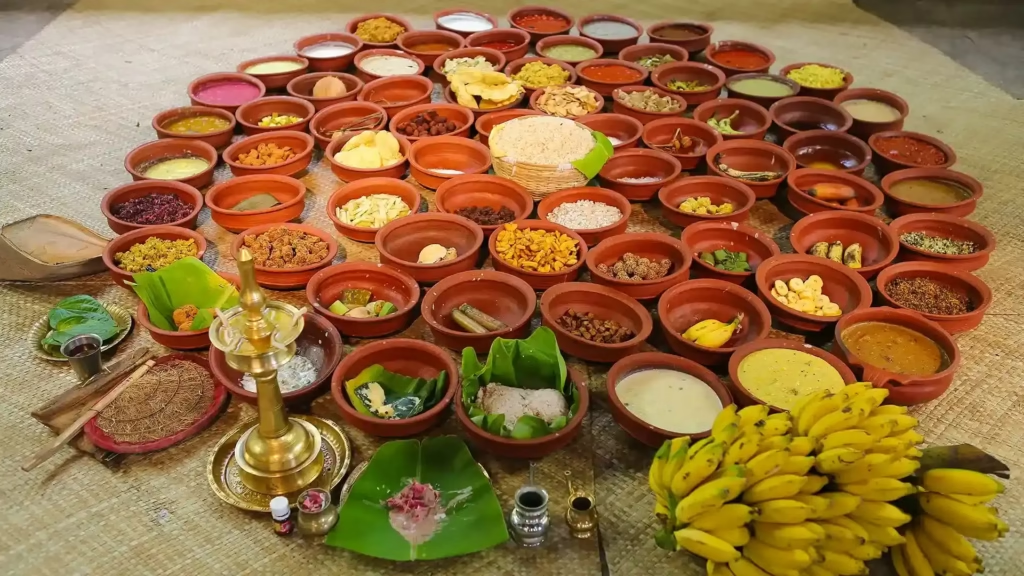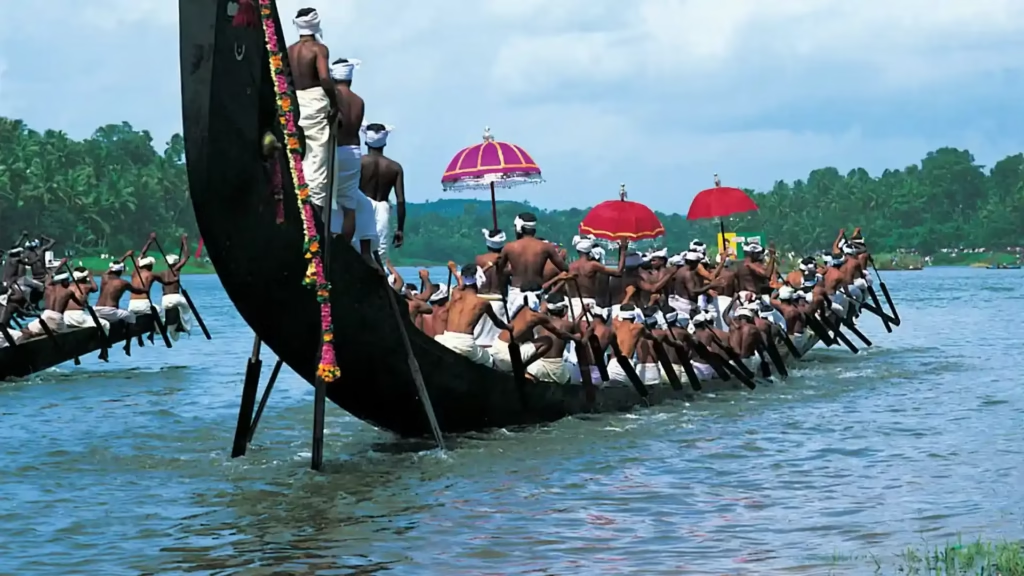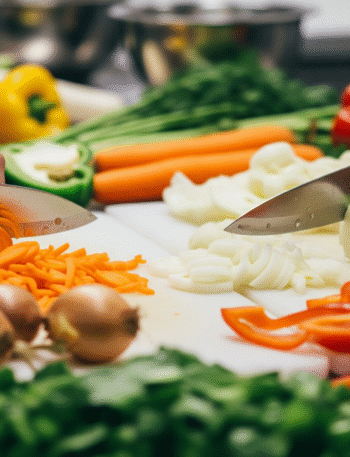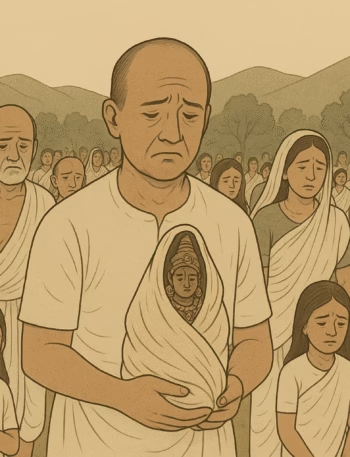
Aranmula Valla Sadya is among India’s grandest ritual feasts, offered to Lord Parthasarathi (Lord Krishna as Arjuna’s charioteer) at the Aranmula Parthasarathi Temple on the banks of the sacred Pamba. The temple’s lore says Krishna once arrived here on a raft of six bamboos — aaru (six) and mula (bamboo) — hence Aranmula. Another legend says Arjuna installed the deity before his Swargarohana. The six-foot idol is revered as Parthasarathi. While many offerings are practiced, here food is the supreme offering. Alongside the famous Valla Sadya, the temple also holds Bhajana Sadya, Thechukuli Sadya, and even Meenoottu (feeding the fish of the Pamba).
The Mangattu Bhattathiri Story
On the banks of the Pamba, near Kattur in Kozhencherry, stood an ancient Brahmin household, Mangattu Illam, famed for Vedic scholarship. One of its members, Mangattu Bhattathiri, took a vow: on every Thiruvonam day he would eat only after performing Kal Kazhichootu — a ritual of offering food and pooja to Brahmins or any guest who came to his home.
One Thiruvonam day he waited long, but no guest arrived. Saddened, he prayed to Lord Krishna. At last, a small Brahmin boy appeared. Overjoyed, Bhattathiri welcomed him, served him lovingly, and performed Adithi Pooja. When the boy was about to leave, Bhattathiri requested, “Please come every year so I can keep my vow.” The boy disappeared without a word. That night, the boy appeared again — in Bhattathiri’s dream — and said: “From next year, bring all that is needed to prepare the Onasadya, cook it, and offer it to me at Aranmula temple.” With that he vanished, and Bhattathiri understood it was the Lord himself.
From the following year, Bhattathiri gathered provisions and set out by boat to Aranmula to offer the Onasadya. Thugs along the river made the passage perilous; seeing this, villagers from different karas began accompanying his boat in snake boats to protect the offering. That ritual of giving company grew into a procession of boats; the sacred snake boats came to be called Palliyodams. In the 1970s, this grand river pageantry took on a competitive race format alongside the ritual processions. And thus, from a single vow of hospitality, Aranmula Valla Sadya blossomed — devotees wishing to offer the Lord rich, royal food, just as Bhattathiri did.

Thiruvonam rule: On Thiruvonam day, no Valla Sadya is served to oarsmen. Only Bhattathiri’s Sadya is ceremonially offered to the Lord.
Ritual Flow and Season
A devotee who sponsors a Valla Sadya must first obtain permission from a kara. There are 28 karas, and one may invite any number of Palliyodams. On the day, the devotee receives the arriving Palliyodams at the jetty with blessed garlands, betel leaves, and areca nut (adakka) as the oarsmen come in traditional attire, rowing to vanchi pattu. They perform a pradakshinam of the temple carrying their oars, then place the oars and the muthukuda (ornamental umbrellas) near the kodimaram (flagstaff) and proceed to the feast. The rituals also include Para Thalikkal. After the Sadya, they return to the shrine, pray for the devotee’s wish-fulfilment, and depart to their kara.
The Valla Sadya season runs from Karkidakam 15 to Kanni 15 (roughly mid-August to mid-September/early October).

The Valla Sadya Experience — Songs and Service
Although 64+ delicacies are prepared, about 44 are served directly on the banana leaf; the rest arrive on request — but not by asking in plain words. The oarsmen sing traditional refrains to “demand” each item, and the servers bring it at once. The hall becomes a musical, devotional theatre:
Famous refrains include:
- “പായസം വേണം, അടപ്രഥമന് കൊണ്ടുവാ”
(“We want payasam, bring ada pradhaman!”) - “അരവന വേണം കൊണ്ടുവാ കൊണ്ടുവാ”
(“We want aravana, bring it now!”) - “പാമ്പാ തീര്ത്ഥം വേണം”
(“We want the holy water of Pamba!”)
This transforms the Sadya into a performance where food, song, and devotion intertwine.
There is no ‘no’ in serving; whatever is sung for must be provided.
The Dishes — Numbered, as in Tradition
Served on the banana leaf / main spread (representative, 44 on leaf; count continues beyond 44 on request):
- Rice
- Parippu (lentil curry)
- Parpidakam (Papad – big and small)
- Ghee
- Sambar
- Pulisseri (curd-based curry)
- Rasam (soup)
- Moru (buttermilk)
- Aviyal
- Madhura Pachadi (sweet curry)
- Pavakka Kichadi (bitter gourd)
- Beetroot Kichadi
- Thoran (stir-fry)
- Inchi Curry (ginger pickle)
- Manga Achar (mango pickle)
- Naranga Achar (lemon pickle)
- Nellikka Achar (gooseberry pickle)
- Chammanthipodi
- Aranmula Varutha Erisseri
- Stew
- Vazhuthananga Mezhukkupuratti (brinjal)
- Pazham Nurukku (sweet plantain)
- Uppu Manga (pickled mango)
- Ethakka Upperi (banana chips)
- Sarkkara Puratti (sweetened banana chips)
- Chembu Upperi (taro chips)
- Chena Upperi (yam chips)
- Unniyappam
- Parippuvada
- Ellunda (sesame balls)
- Kalkadam
- Karutha Munthirri (black raisins)
- Aval (flattened rice)
- Malar (puffed rice)
- Panchasara (white sugar)
- Unda Sarkkara (jaggery)
- Karimbu (sugar cane)
- Ada Pradhaman
- Palpayasam
- Kadala Pradhaman
- Pazham Payasam
- Pazham (banana)
- Karingali Vellam
- Uppu (salt)
Additional dishes served on request (by song):
- Venna (butter)
- Aravana Payasam
- Sarkkara Payasam
- Kaalipazham
- Poovan Pazham
- Kadali Pazham
- Then (honey)
- Chukku Vellam
- Ambazhanga Achar
- Olan
- Cheera Thoran (spinach)
- Madanthayila Thoran
- Thakara Thoran
- Modakam
- Pazhutha Mangakari
- Ada
- Inchi Thairu
- Vazhakoombu Thoran
- Paala Thairu
- Velli Kindi Palu
- Unni Unda Sesham (Nivedya Choru)
- Pamba Theertham
Aranmula Valla Sadya is thus devotion expressed as hospitality: from Bhattathiri’s Thiruvonam vow to the palliyodams that escort the offering, from songs that summon dishes to the oars and muthukuda resting by the kodimaram. It is Kerala’s living poem of faith, food, river, and community — a feast truly royal and rich for the Lord.



